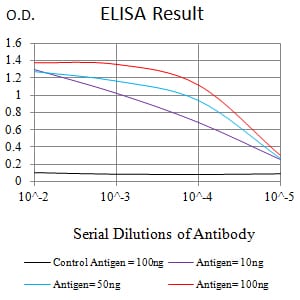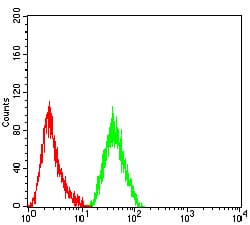

| WB | 咨询技术 | Human,Mouse,Rat |
| IF | 咨询技术 | Human,Mouse,Rat |
| IHC | 1/200-1/1000 | Human,Mouse,Rat |
| ICC | 技术咨询 | Human,Mouse,Rat |
| FCM | 1/200-1/400 | Human,Mouse,Rat |
| Elisa | 1/10000 | Human,Mouse,Rat |
| Aliases | L1CAM; S10; HSAS; MASA; MIC5; SPG1; CAML1; HSAS1; N-CAML1; NCAM-L1; N-CAM-L1 |
| Entrez GeneID | 3897 |
| clone | 5C6A10 |
| WB Predicted band size | 140kDa |
| Host/Isotype | Mouse IgG1 |
| Antibody Type | Primary antibody |
| Storage | Store at 4°C short term. Aliquot and store at -20°C long term. Avoid freeze/thaw cycles. |
| Species Reactivity | Human |
| Immunogen | Purified recombinant fragment of human CD171 (AA: 20-197) expressed in E. Coli. |
| Formulation | Purified antibody in PBS with 0.05% sodium azide |
+ +
以下是关于CXCL16抗体的3篇参考文献示例(内容基于公开研究概括,具体文献需根据实际数据库检索确认):
---
1. **文献名称**: *CXCL16中和抗体抑制动脉粥样硬化斑块炎症*
**作者**: Wuttge DM 等
**摘要**: 研究通过靶向CXCL16的中和抗体阻断其与受体CXCR6的相互作用,发现可显著减少小鼠动脉粥样硬化模型中的巨噬细胞浸润和斑块形成,表明CXCL16抗体在抗炎治疗中的潜力。
2. **文献名称**: *靶向CXCL16/SR-PSOX的抗体抑制肝癌细胞迁移*
**作者**: Zhuang G 等
**摘要**: 研究证明CXCL16在肝癌细胞中高表达,其抗体通过抑制CXCL16介导的ERK信号通路,有效降低肝癌细胞的侵袭和转移能力,提示其在肿瘤治疗中的应用价值。
3. **文献名称**: *可溶性CXCL16抗体在类风湿性关节炎中的治疗作用*
**作者**: Kim CH 等
**摘要**: 该研究开发了针对可溶性CXCL16的特异性抗体,并在关节炎模型中发现其能减少关节滑膜炎症和骨质破坏,机制可能与抑制Th17细胞活化相关。
---
如需具体文献,建议通过PubMed或Google Scholar检索关键词“CXCL16 antibody” + 研究领域(如cancer, inflammation等)获取最新论文。
CXCL16. a member of the CXC chemokine family, exists in both soluble and transmembrane forms. The transmembrane isoform functions as a scavenger receptor for oxidized low-density lipoprotein (oxLDL) and mediates cell adhesion, while the soluble form, generated via proteolytic cleavage by disintegrin and metalloproteinases (ADAMs), acts as a chemoattractant for CXCR6-expressing immune cells, such as T cells and natural killer (NK) cells. CXCL16 plays dual roles in inflammation and homeostasis, participating in immune surveillance, leukocyte trafficking, and lipid metabolism.
CXCL16 antibodies are essential tools for studying its expression, localization, and function in physiological and pathological contexts. They enable detection of CXCL16 in tissues (e.g., by immunohistochemistry) or biological fluids (e.g., by ELISA) and are used to block CXCL16-CXCR6 interactions in functional assays. Dysregulation of CXCL16 is implicated in diseases like atherosclerosis, rheumatoid arthritis, and cancer. In cancer, CXCL16 may promote tumor progression by recruiting immunosuppressive cells or inducing angiogenesis, making it a potential therapeutic target.
Research utilizing CXCL16 antibodies has highlighted its role as a biomarker in cardiovascular diseases and autoimmune disorders. Neutralizing antibodies are being explored to inhibit pro-inflammatory or pro-tumorigenic signaling pathways. However, the pleiotropic nature of CXCL16 necessitates careful evaluation of therapeutic strategies to avoid disrupting its homeostatic functions.
×